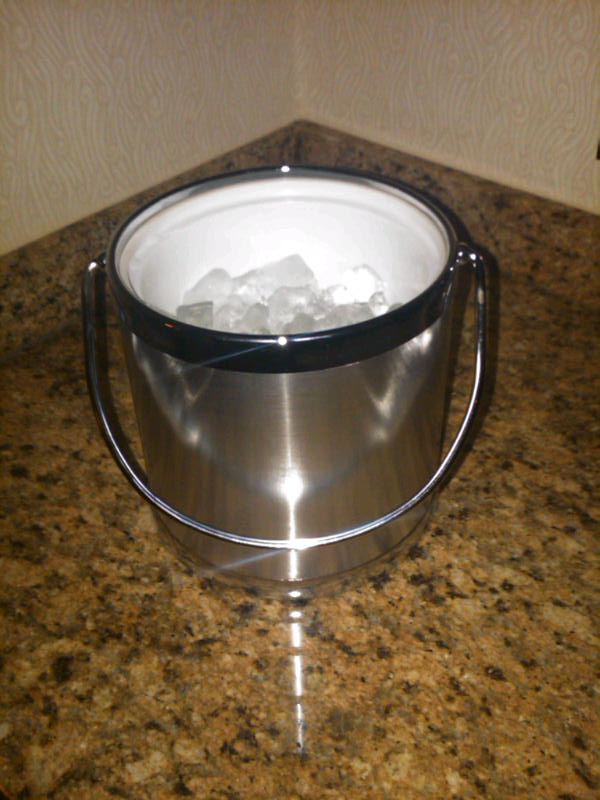Notes From the Road #4 - Ice Buckets and Usability
I've stayed in plenty of hotels these last few years, and have found that fewer and fewer standard hotel rooms come equipped with in-room refrigeration of any kind. First the stocked mini-bar started to fall out of fashion in most rooms a couple of years ago, often to have the empty space replaced with one of those mini, college dorm-sized refrigerators. Which was to me, a far better deal anyway. The days of casually dropping $7.25 on a can of mini-bar Miller Lite or $3.75 for a Snickers bar have came and went with the pressure faced by organizations and people to carefully watch travel expenses. At least with an in-room refrigerator, one could store some extra beverages or snacks without having constantly hit the vending machine or wonder in the morning if it is ok to drink orange juice that has been sitting on the table all night, (it probably is not ok.) It needs a cold beverage.
It needs a cold beverage.
But lately most hotels I've been in seem to have dropped the mini-refrigerators as well. I imagine it was simply a cost/usage decision. Many hotel guests were apparently not using the refrigerators all that much, and the energy costs to keep potentially hundreds of these appliances running when compared with their limited use made for what was probably a simple decision - get rid of the refrigerators. Not a big deal really, a convenience sure, but not generally a trip ruining development. Besides, there's always that ever present hotel room ice bucket and industrial ice machine down the hall.
Yep the ice bucket - that normally utilitarian device that is generally only used in hotel rooms, and typically is designed with about as much thought and care as is to be expected from a tool that for the most part simply needs to keep a pound or so of ice and the one, (maybe two) beverages that can be squeezed into the full bucket. Most hotel room ice buckets are the same - round, flimsy, and cheap. In fact, most of the time the combination of overfilling, (who wants to march down the hotel hallway more than once), the round shape of the bucket making one-hand operation tricky, and the vagaries of hotel room door locks tend to combine to make the entire ice-bucket experiences a bit of a hassle.
What could solve this little, (and I agree, problems with hotel room ice buckets are squarely a first world problem), conundrum and make the usability about 100x better? Simple: a handle on the bucket.
The picture on the right shows the ice bucket in my room this week at a Marriott in New York. Sturdier than the garden variety model and possessing what I have found to be the rarest and most needed of features - a HANDLE. The handle, a small and probably inexpensive add-on improves and enhances the experience immeasurably. The handle allows you to carry the bucket easily in one hand, (important for those many, many hotel rooms that are about 7 miles from the ice machine), and re-open your room door without having to balance the cold, overfilled bucket against your body or set it on the floor as you fumble with the elecronic lock that may or may not feel like co-operating with you.
Whomever designed this particular ice bucket realized something very important - that while the bucket's 'job' is to hold a small amount of ice and keep a drink cold for a few hours, that is a passive use case. When the actual users interact with the bucket, they are CARRYING it, half of that time filled with ice and needing to open a door. The designers thought not just the functions, but about the process and the experience of actually using the bucket. Something they could have easily missed if they focused too much on 'ice melt rate' and 'temperature after 3 hours' and not on the environments and challenges inherent on where and how the ice buckets would actually be used. Something they might not have appreciated if they never left the confines of their design lab and ventured out into the environments where their product would be used.
Have a made too much about this? About 800 words about an ice bucket? Probably so. But to me the handle on the ice bucket reinforces a great lesson no matter what you are in charge of building - tools, technologies, or processes.
You'll never know if they will work until you try them in the field. Better to do that when designing and not after you've contracted with a Chinese supplier to build a few hundred thousand units.

 Steve
Steve
Reader Comments (2)
Excellent point + glad it worked out for you :) ... there are other beneficiaries like the people in hotel rooms around you that didn't experience the side effects after you (might have) fumbled, dropped the bucket, spilled ice all over the hallway, & sweared ... not that I think that would ever happen with you.
Thank Christine - no doubt I would have made some kind of scene (and probably have in the past!). I am coming to appreciate the little design differences that seem to make a much greater impact than it would seem on the surface. Thanks for reading!